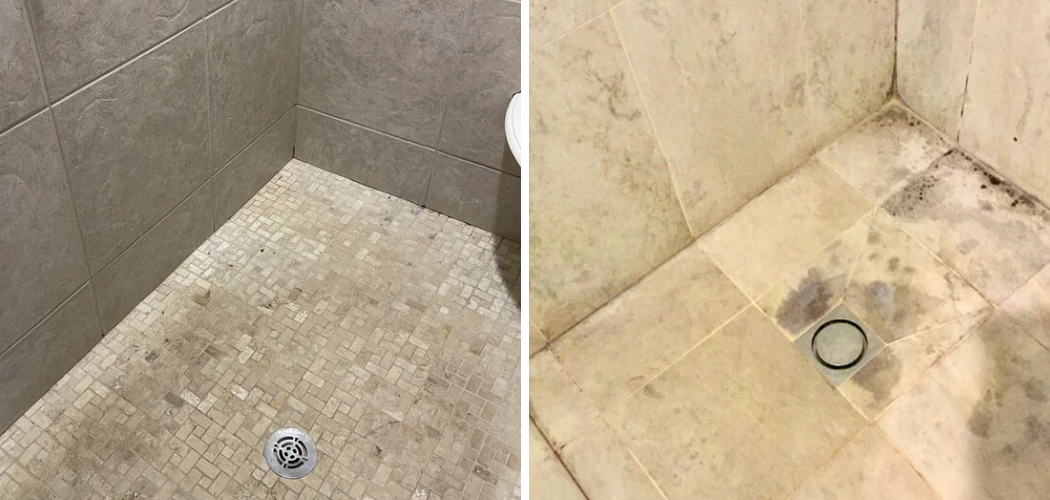Mold in the shower is not just an unsightly nuisance; when it invades the porous surfaces of natural stone, it presents a particularly stubborn challenge. For homeowners who take pride in their elegant natural stone showers, understanding how to remove mold from natural stone shower is vital. Mold does more than mar the beauty of natural stone with its black, green, or gray stains.
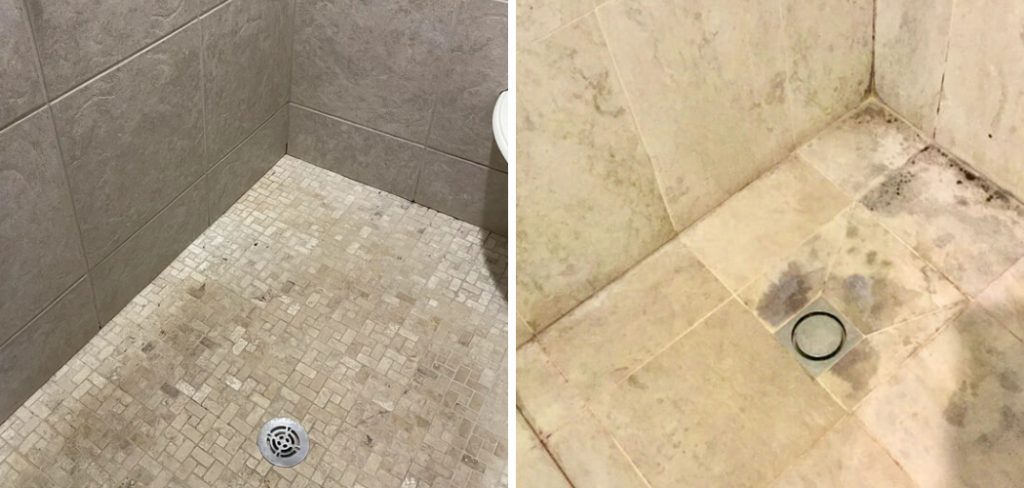
Its presence in damp environments like bathrooms can pose health risks, ranging from allergic reactions to more serious respiratory issues for those living in the home. This guide aims to arm you with the knowledge to tackle mold effectively, preserving your natural stone shower’s aesthetic and structural integrity and ensuring a healthy living environment.
The battle against mold is not only about immediate removal. Still, it encompasses understanding its growth cycle, the risks it poses to health and home, and the steps necessary for preventing its return.
Characteristics of Natural Stone
Natural stone has long been cherished for its beauty and durability, making it a popular choice for shower construction. Renowned types include marble, granite, and slate, each possessing unique characteristics that contribute to a shower’s aesthetic and functional appeal.
Marble, with its luxurious veining, adds elegance to any bathroom. Granite, known for its durability and array of colors, stands up well to constant moisture. Slate offers a more rustic look with its natural texture and color variations. Despite their differences, these stones share a common vulnerability – porosity.
This porous nature means that water, and thereby mold spores, can seep into the tiny crevices of the stone if not properly sealed. In environments as perpetually moist as showers, this makes natural stone surfaces susceptible to mold growth, which not only detracts from their appearance but can also cause damage over time. The absorption of water can lead to the weakening of the stone’s structural integrity, making it paramount to address mold promptly and effectively.
Given this susceptibility, gentle cleaning methods are crucial for caring for natural stones. Harsh chemicals or abrasive cleaning tools can etch or damage the stone’s surface, leading to further complications.
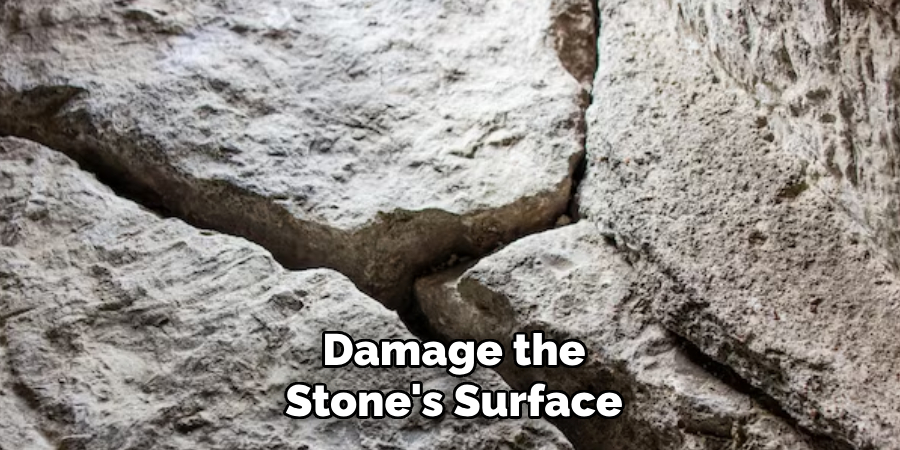
Gentle, pH-neutral solutions should be employed to cleanse the stone, preserving its natural beauty while ensuring it remains free from mold and mildew. Understanding the characteristics of natural stone and treating it with care is foundational to maintaining its elegance and durability in a shower setting.
Identifying Mold in Natural Stone Showers
Identifying mold in natural stone showers is the first critical step toward maintaining a clean, healthy bathing environment. Homeowners should be vigilant for signs and symptoms of mold growth, which can manifest in several ways. Discoloration on the stone surfaces or grouting — often appearing as black, green, or gray patches — is a clear indicator of mold presence.
Another unmistakable sign is the emergence of a musty odor within the shower area, which is indicative of mold growing in less visible spots, possibly beneath the surface of the stone or inside crevices.
A. Recognizing Signs and Symptoms of Mold Growth in Shower Areas
Besides the visual signs and distinct smells, the presence of excessive moisture or water pooling in certain areas of the shower can also signify a potential mold issue. Homeowners should regularly inspect their showers, paying close attention to changes in color or texture that may suggest mold growth.
B. Inspecting Grout Lines, Tile Surfaces, and Shower Fixtures for Visible Mold Spores
Particular attention should be given to grout lines, tile surfaces, and shower fixtures, as these areas commonly harbor mold spores due to their frequent exposure to moisture. Visible mold spores, which may look like small black or green dots, should prompt immediate action to mitigate spread and damage.
C. Understanding the Importance of Prompt Action to Prevent Spread and Damage from Mold
Promptly identifying and addressing mold in natural stone showers is crucial not only for the aesthetics and longevity of the stone but also for the health and safety of household members. Mold can quickly spread to larger areas and penetrate deeper into the stone if left untreated, leading to more significant damage over time. Understanding the urgency in dealing with mold growth ensures that natural stone showers remain both beautiful and safe for all who use them.
Risks and Consequences of Mold Growth
Exposure to mold in shower environments can pose significant health risks to individuals, particularly those with pre-existing respiratory conditions, allergies, or weakened immune systems. Mold spores, when inhaled, can trigger allergic reactions and asthma attacks and even lead to long-term respiratory issues. These health concerns underscore the importance of promptly addressing mold growth in areas as frequently used as showers.

Furthermore, mold infestation can result in extensive damage to natural stone surfaces and grout over time. The porous nature of these materials allows mold to penetrate deeply, causing discoloration, weakening of the structural integrity, and, in severe cases, irreversible damage. This not only affects the stone’s aesthetic appeal but can also lead to costly repairs or replacements necessary to preserve the shower’s functionality and appearance.
Regular maintenance and diligent cleaning of natural stone showers are paramount to prevent the onset of mold growth. Implementing routine inspections for signs of moisture or mold, ensuring proper ventilation, and employing gentle, appropriate cleaning solutions will help maintain the natural beauty and safety of the shower environment.
It’s a proactive approach that safeguards both the health of household members and the longevity of the natural stone surfaces, thereby avoiding the risks and consequences associated with mold growth.
Preparation and Safety Measures
Effective mold removal from natural stone showers requires vigilance, prompt action, preparation, and rigorous safety measures. Gathering the necessary supplies and equipment before initiating the cleaning process is crucial to ensure an efficient and safe outcome.
A. Gathering Necessary Supplies and Equipment for Mold Removal
For mold removal, protective gear such as gloves, goggles, and face masks should be at the top of your checklist to prevent direct contact with mold spores and harsh cleaning agents. Non-abrasive cleaning solutions specifically designed for natural stone, soft-bristled brushes, and microfiber cloths are essential to cleaning without damaging the stone surfaces. Having these supplies at hand fosters a prepared environment for effective mold remediation.
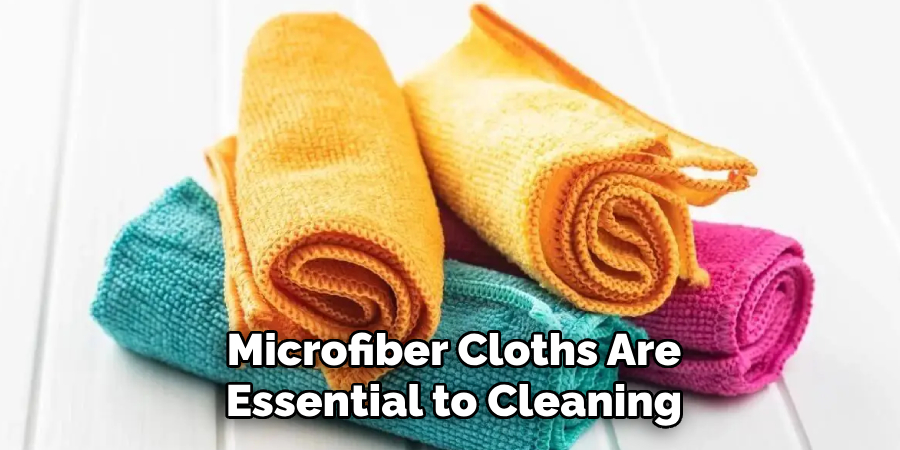
B. Ensuring Adequate Ventilation and Air Circulation in the Shower Area During the Cleaning Process
Ensuring adequate ventilation within the shower area is a critical step in preparing for mold removal. Opening windows and doors or employing exhaust fans expels harmful spores and strong fumes from cleaning agents, safeguarding the health of the cleaner and promoting the drying of surfaces post-cleaning. This step is indispensable for maintaining an environment conducive to effective and safe mold eradication.
C. Taking Precautions to Protect Surrounding Surfaces and Fixtures from Damage
Protecting non-targeted surfaces and fixtures is vital during the mold removal process. Utilizing plastic sheeting or old towels to cover surrounding areas prevents potential damage from cleaning solutions and mold spores. This precaution ensures that the integrity and aesthetics of the bathroom remain intact post-cleaning, emphasizing a thorough yet mindful approach to mold remediation.
How to Remove Mold from Natural Stone Shower: Gentle Cleaning Methods
Removing mold from natural stone surfaces in shower areas requires careful consideration of the cleaning methods and products used to preserve the stone’s integrity and appearance. The focus should be on gentle yet effective strategies to address mold issues without harming these valuable surfaces.
A. Using pH-Neutral or Mild Cleaning Solutions to Remove Mold from Natural Stone Surfaces
It is essential to select pH-neutral or mild cleaning solutions specifically formulated for natural stone use. These types of cleaners effectively remove mold and mildew without altering the stone’s natural characteristics.
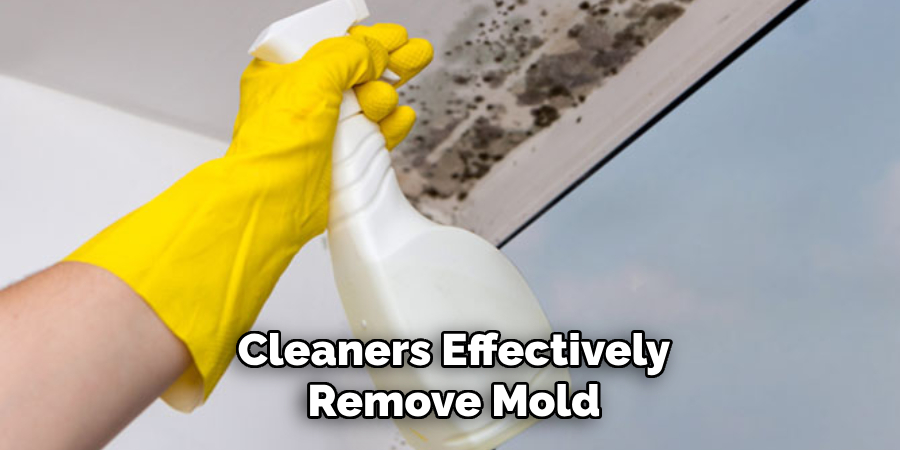
Before applying any solution, it is advisable to conduct a spot test in an inconspicuous area to ensure there is no adverse reaction. Once confirmed, the cleaner can be applied directly to the affected areas, allowing it to sit for the recommended duration before gently wiping it away.
B. Avoiding Harsh Chemicals or Abrasive Cleaners that Can Damage or Etch Stone Surfaces
Harsh chemicals, including bleach and ammonia or abrasive cleaners, should be strictly avoided as they can etch the surface of natural stone, leading to dullness and potential damage. The microscopic pores of natural stone can also trap these chemicals, leading to discoloration and weakening of the stone over time. Opting for stone-safe products will prevent such damage and ensure the longevity of the shower’s surfaces.
C. Applying Gentle Scrubbing Techniques with Soft-Bristled Brushes or Sponges to Remove Mold
Gentle scrubbing techniques should be employed to physically remove mold from stone surfaces. Using soft-bristled brushes or non-abrasive sponges can effectively dislodge mold spores without scratching or harming the stone.
Circular motions with light pressure will help to lift the mold from the pores of the stone, facilitating a thorough cleaning without causing surface damage. Rinsing with clean water and drying the area promptly after cleaning will help to prevent mold from returning, keeping the natural stone surfaces in pristine condition.
Targeted Treatment for Mold Removal
Targeted treatment strategies are crucial in effectively dealing with mold on natural stone surfaces within shower areas. These strategies not only aim at eradicating existing mold growth but also at preventing its recurrence. Utilizing both natural remedies and commercial products tailored for natural stone ensures the preservation of stone integrity while maximizing mold removal efficacy.
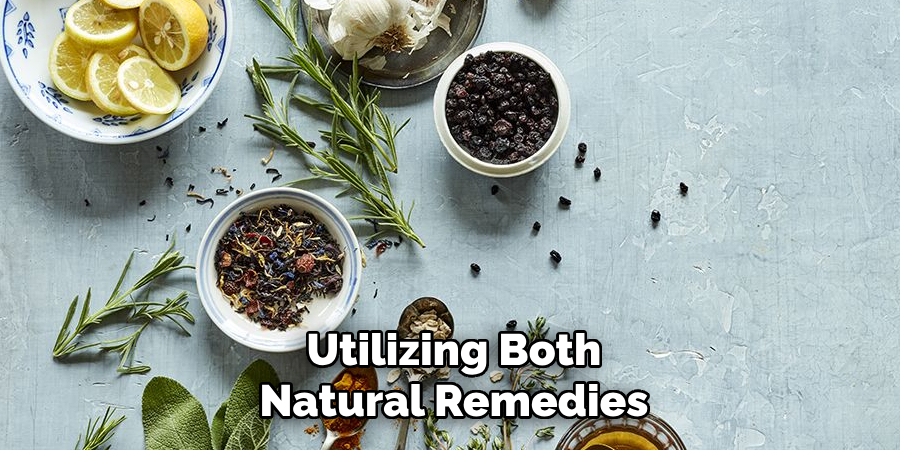
A. Applying Natural Remedies such as Vinegar, Baking Soda, or Hydrogen Peroxide to Kill Mold Spores
Natural remedies offer a safe and eco-friendly approach to mold removal on natural stone surfaces. With its mild acidity, vinegar can be an effective agent against mold. Applying diluted white vinegar on the affected area and allowing it to sit for an hour before rinsing can help kill mold spores.
Baking soda, another benign but potent cleaner, can be used in a paste form or dissolved in water to treat mold areas. It works by absorbing moisture and neutralizing mold odors. Hydrogen peroxide, a mild antiseptic, can also be applied directly to moldy surfaces using a spray bottle. These remedies are gentle on the stone while being tough on mold, making them ideal for natural stone care.
B. Using Commercial Mold Cleaners or Disinfectants Specifically Designed for Natural Stone Surfaces
Commercial mold cleaners and disinfectants formulated for natural stone are recommended for more stubborn mold infestations. These products are designed to effectively combat mold growth without the risk of damaging the stone’s surface.
Following the manufacturer’s instructions regarding application and dwell time is important to ensure the product’s effectiveness and safety. Commercial cleaners often contain ingredients that penetrate deeper into the pores of the stone, providing a thorough cleaning and disinfection.
C. Allowing Sufficient Dwell Time for Cleaning Solutions to Penetrate and Break Down Mold Growth
Regardless of the chosen treatment—be it a natural remedy or a commercial cleaner—allowing sufficient dwell time is key in ensuring that the cleaning solution effectively penetrates and breaks down mold growth. This dwell time varies depending on the product and the severity of the mold infestation but generally ranges from ten minutes to an hour.
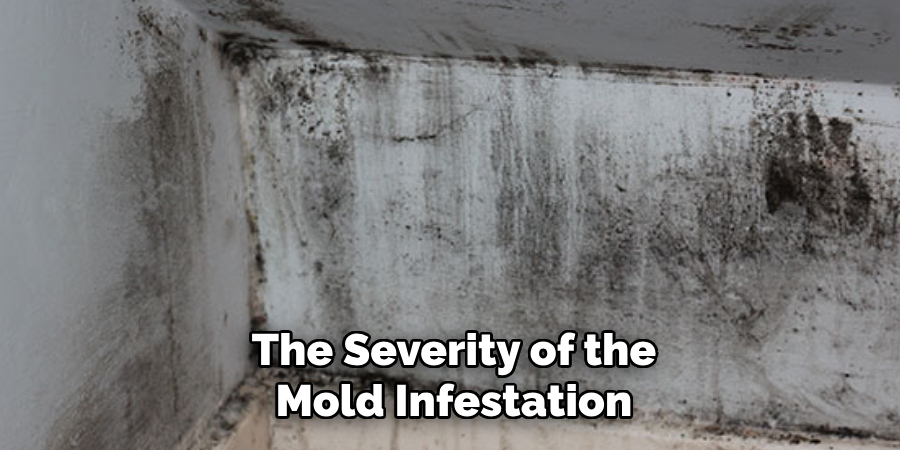
During this period, the cleaning agent works to weaken and kill the mold spores, making it easier to eliminate them completely during the subsequent rinsing and scrubbing process. Ensuring adequate dwell time significantly enhances the efficacy of the mold removal treatment, leaving the natural stone surfaces clean, safe, and preserved.
How to Remove Mold from Natural Stone Shower: Deep Cleaning and Restoration
Deep cleaning processes play a pivotal role in effectively tackling stubborn mold stains that persist on natural stone surfaces. In cases where routine cleaning and targeted treatments fail to fully eradicate mold, resorting to deep cleaning techniques becomes essential. These methods may involve specialized cleaning agents and equipment designed to penetrate deeper into the stone’s porous surface, dislodging and removing entrenched mold spores.
For particularly severe mold infestations or when the stone has been damaged, seeking professional cleaning services or restoration techniques is advisable. These experts are equipped with the knowledge and tools necessary to restore natural stone to its original condition while ensuring that the integrity and beauty of the material are maintained.
Implementing preventive measures is crucial to safeguarding against future mold growth. Adequate ventilation and moisture control within natural stone shower areas reduce the damp conditions mold requires to thrive.
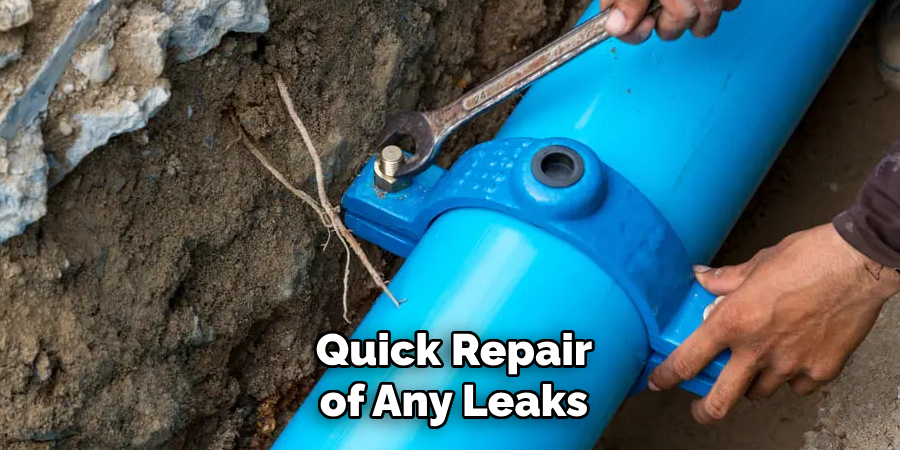
Regular cleaning with suitable products, quick repair of any leaks, and ensuring water doesn’t stand on stone surfaces contribute significantly to preventing mold challenges before they start. By maintaining these practices, the risk of mold recurrence in natural stone showers can be significantly minimized, preserving both the aesthetic appeal and the longevity of the surfaces.
Regular Maintenance Practices
Maintaining the beauty and integrity of natural stone showers requires consistent and careful maintenance practices. Regular maintenance not only contributes to preventing mold growth but also extends the lifespan of the stone surfaces, keeping them looking as pristine as the day they were installed.
A. Establishing a Routine Cleaning Schedule for Natural Stone Showers to Prevent Mold Growth
Creating and adhering to a routine cleaning schedule is paramount in preventing mold growth on natural stone surfaces. It is recommended that these surfaces be cleaned at least once a week with stone-safe products.
This routine should include the application of a mild cleanser, followed by a thorough rinse with clean water. Establishing this habit helps in preventing the accumulation of soap scum, hard water deposits, and other debris that can harbor mold spores.
B. Wiping Down Shower Surfaces After Each Use to Remove Excess Moisture and Prevent Mold Formation
Another effective preventive measure against mold is to wipe down natural stone surfaces immediately after each shower use. Using a soft, clean towel or a squeegee to remove excess water eliminates standing moisture, which is a key contributor to mold formation. This simple yet effective practice significantly reduces the likelihood of mold and mildew establishing themselves on the stone surfaces.
C. Inspecting Grout Lines and Tile Surfaces Regularly for Signs of Mold and Addressing Promptly
Regular inspection of grout lines and tile surfaces for any signs of mold is crucial for early detection and prevention. If any mold is spotted, it must be addressed promptly using the appropriate cleaning methods detailed previously. Paying close attention to grout lines, which can easily become breeding grounds for mold due to their porous nature, ensures that any mold growth is stopped in its tracks before it can spread further.
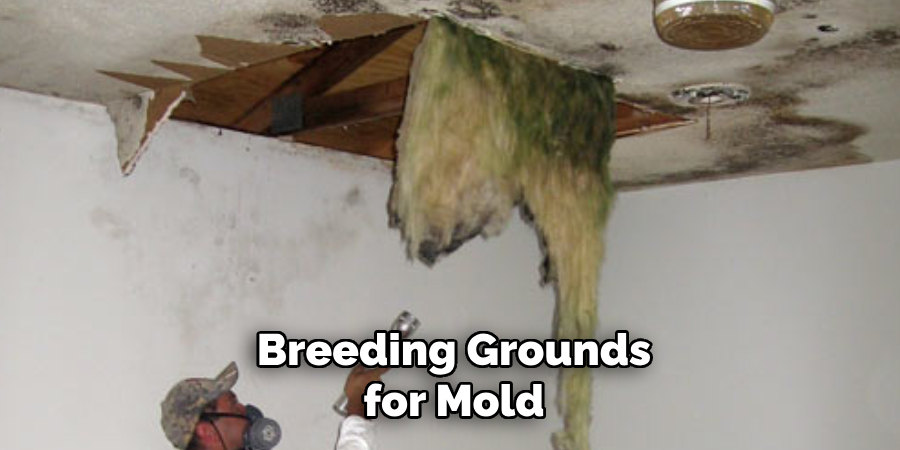
Implementing these regular maintenance practices strengthens the defense against mold growth, safeguarding the beauty and durability of natural stone showers.
Preventive Measures for Long-Term Mold Prevention
Preventive measures play a crucial role in ensuring the long-term durability and aesthetic appeal of natural stone showers, effectively minimizing the risk of mold infestation. By adopting certain practices and utilizing specific products, homeowners can significantly reduce the likelihood of mold growth and maintain the pristine condition of their natural stone surfaces.
A. Applying Sealants or Protective Coatings to Natural Stone Surfaces to Prevent Moisture Penetration
One of the most effective strategies for preventing mold growth is the application of sealants or protective coatings to natural stone surfaces. These products create a barrier that minimizes moisture penetration, a key factor in mold formation.
It’s recommended to reapply sealants periodically, typically every one to two years, depending on the stone’s porosity and the product’s specifications. Choosing a high-quality sealant designed for natural stone can provide lasting protection and preserve the stone’s natural beauty.
B. Using Mold-Resistant Grout or Sealants in Shower Construction or Renovation Projects
During the construction or renovation of natural stone showers, opting for mold-resistant grout or sealants can significantly contribute to long-term mold prevention. These products are specially formulated to resist moisture absorption and inhibit mold growth, offering an additional layer of protection for grout lines and adjacent stone surfaces. Incorporating these materials from the outset can greatly enhance the shower’s resistance to mold and mildew.
C. Educating Household Members on Proper Shower Maintenance and Mold Prevention Practices
Educating all household members on the importance of proper shower maintenance and mold prevention practices is vital in sustaining the health and appearance of natural stone surfaces.
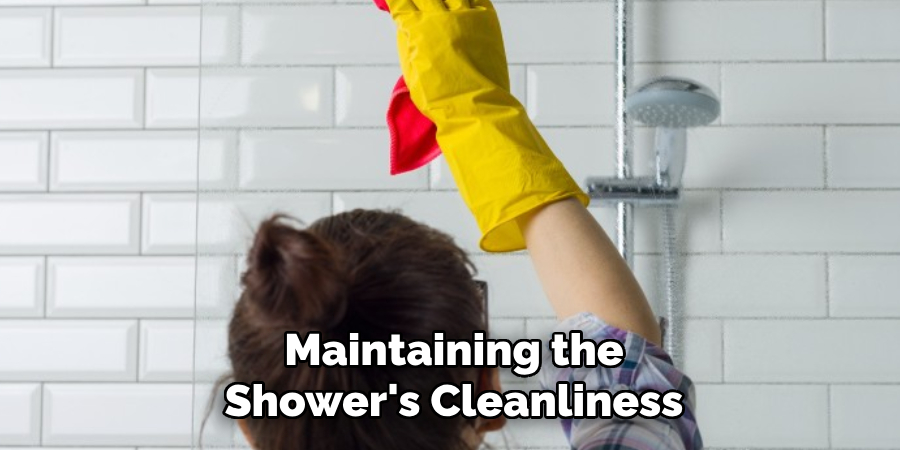
Simple habits, such as using a squeegee to remove excess water after showering, ensuring proper ventilation, and promptly addressing any leaks or moisture issues, can collectively make a significant impact. Encouraging a shared responsibility for maintaining the shower’s cleanliness and dryness can help prevent mold growth and ensure the longevity of the natural stone surfaces.
Final Thoughts
This guide outlines comprehensive techniques and strategies for effectively addressing and preventing mold growth on natural stone shower surfaces. Key to successful mold removal is prompt detection and the use of stone-safe cleaning agents, ensuring that the natural beauty and integrity of the stone are preserved. Regular maintenance, including weekly cleaning with appropriate products and drying surfaces after each use, forms the cornerstone of mold prevention.
Equally crucial is the application of sealants or protective coatings to reduce moisture penetration, alongside choosing mold-resistant grout or sealants during construction or renovation projects.
Educating all household members on proper maintenance practices ensures a collective effort to keep the shower environment clean and dry. By integrating these measures, homeowners can significantly mitigate the risk of mold growth, maintaining their natural stone showers’ aesthetic and functional quality.
The battle against mold in natural stone showers encompasses more than just periodic cleaning; it embodies a proactive and vigilant approach toward maintenance and care. Regular maintenance not only prevents mold growth but also preserves the natural stone’s elegance and durability.
More than just aesthetic value, a mold-free shower ensures a healthier living environment. Prompt action at the first sign of mold—employing effective techniques on how to remove mold from natural stone shower—can save both time and resources in the long run.
This guide serves as a comprehensive resource, aiming to empower homeowners with the knowledge and practices necessary for maintaining mold-free and healthy shower environments. By adhering to the preventive measures and maintenance practices outlined, you can enjoy the timeless beauty of natural stone showers without the worry of mold invasion.

